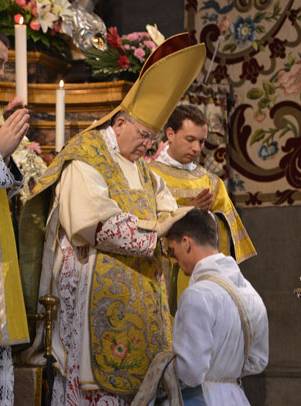
 N THIS POST, I would simply like to share two excellent but little-known texts from the Magisterium—one from Pope Pius XII on November 2, 1954 (in which he also quotes liberally from his great 1947 encyclical on the liturgy, Mediator Dei), and the other from the Congregation for the Doctrine of the Faith in 1973.
N THIS POST, I would simply like to share two excellent but little-known texts from the Magisterium—one from Pope Pius XII on November 2, 1954 (in which he also quotes liberally from his great 1947 encyclical on the liturgy, Mediator Dei), and the other from the Congregation for the Doctrine of the Faith in 1973.
Here is what Pope Pius XII said on November 2, 1954, to cardinals, archbishops, and bishops gathered in Rome for ceremonies in honor of Our Lady:
THERE ARE SOME who have not ceased claiming a certain true power to offer sacrifice on the part of all, even laymen, who piously assist at the sacrifice of the Mass. Opposing them, We must distinguish truth from error, and do away with all confusion. Seven years ago, in the same Encyclical We just quoted, We reproved the error of those who did not hesitate to state that Christ’s command, “do this in remembrance of Me,” “refers directly to the entire assembly of the faithful, and only afterwards did a hierarchical priesthood follow. Hence, they say, the people possess a true sacerdotal power, the priest acts only on an authority delegated by the community. Wherefore they think that ‘concelebration’ is the true Eucharistic sacrifice, and that it is more fitting for priests and people together to ‘concelebrate’ than to offer the Sacrifice in private, with no congregation present.” We also recalled to mind, in that Encyclical, in what sense the celebrating priest can be said “to take the place of the people”; namely “because he bears the person of Jesus Christ our Lord, Who is the head of all the Members, and offers Himself for them; thus the priest goes to the altar as a minister of Christ, subordinate to Christ, but ranking above the people. The people, however, since in no way do they bear the person of our Divine Redeemer, and are not mediators between themselves and God, cannot in any way share in sacerdotal rights.”
On the other hand, it should not be denied or called in question that the faithful have a kind of “priesthood,” and one may not depreciate or minimize it. For the Prince of the Apostles, in his first Letter, addressing the faithful, uses these words: “You, however, are a chosen race, a royal priesthood, a holy nation, a purchased people” (1 Pet. 2:9); and just before this, he asserts that the faithful possess “a holy priesthood, to offer spiritual sacrifices, acceptable to God through Jesus Christ” (ibid. 2:5). But whatever is the full meaning of this honorable title and claim, it must be firmly held that the “priesthood” common to all the faithful, high and reserved as it is, differs not only in degree, but in essence also, from priesthood fully and properly so called, which lies in the power of offering the sacrifice of Christ Himself, since he bears the person of Christ, the supreme High Priest.
As if to further develop these thoughts, the Congregation for the Doctrine of the Faith issued an instruction in 1973 entitled Mysterium Ecclesiae, which addressed many disputed questions of that turbulent time, including the nature of the ordained ministry. (The internal quotations are taken from the Second Vatican Council’s Dogmatic Constitution on the Church, Lumen Gentium.)
Christ the Lord, the High Priest of the new and everlasting covenant, wished to associate with His perfect priesthood and to form in its likeness the people He had bought with His own blood (cf. Heb. 7:20-22, 26-28; 10:14, 21). He therefore granted His Church a share in His priesthood, which consists of the common priesthood of the faithful and the ministerial or hierarchical priesthood. These differ from each other not only in degree but also in essence; yet they are mutually complementary within the communion of the Church.
The common priesthood of the laity, which is also rightly called a royal priesthood (cf. 1 Pt. 2:9; Rev. 1:6; 5:9ff.) since through it the faithful are united as members of the messianic people with their heavenly King, is conferred by the sacrament of Baptism. By this sacrament “the faithful are incorporated into the Church and are empowered to take part in the worship of the Christian religion” in virtue of a permanent sign known as a character; “reborn as children of God they are obliged to profess before men the faith which they have received from God through the Church.” Thus those who are reborn in Baptism “join in the offering of the Eucharist by virtue of their royal priesthood. They likewise exercise that priesthood by receiving the sacraments, by prayer and thanksgiving, by the witness of a holy life, and by self-denial and active charity.” […]
Priests, acting in the person of Christ the Head, offer this Sacrifice in the Holy Spirit to God the Father in the name of Christ and in the name of the members of His Mystical Body. This sacrifice is completed in the holy supper by which the faithful, partaking of the one body of Christ, are all made into one body (cf. 1 Cor. 10:16ff.).

Please visit THIS PAGE to learn more about Dr. Kwasniewski’s Sacred Choral Works and the audio CDs that contain recordings of the pieces.

